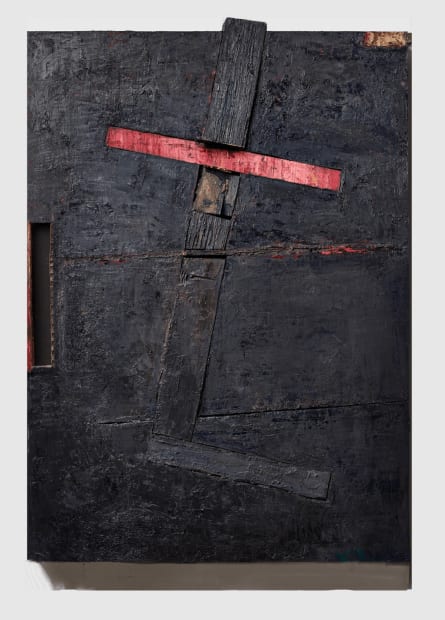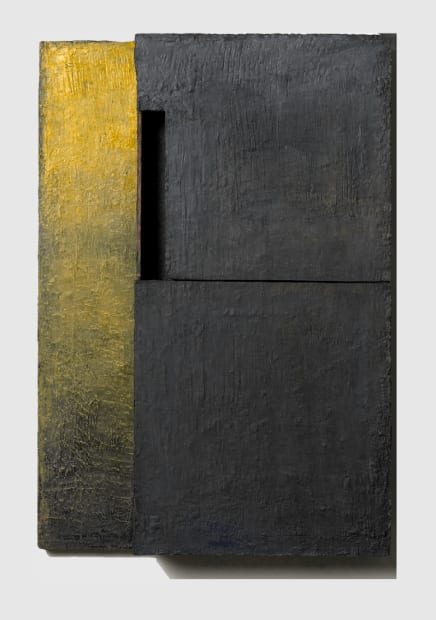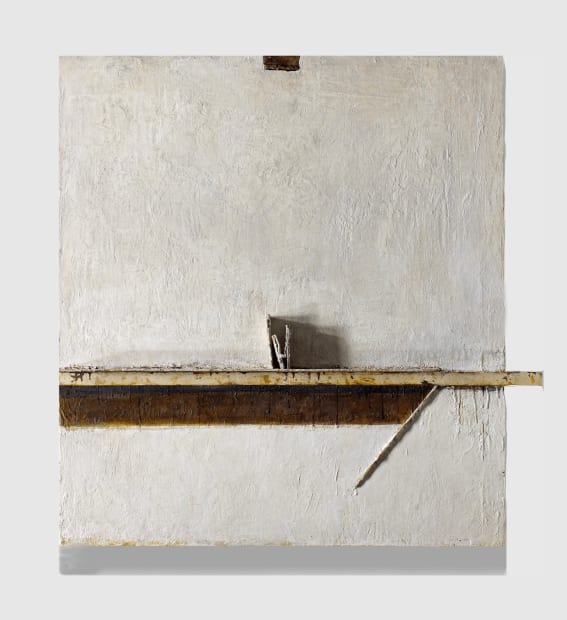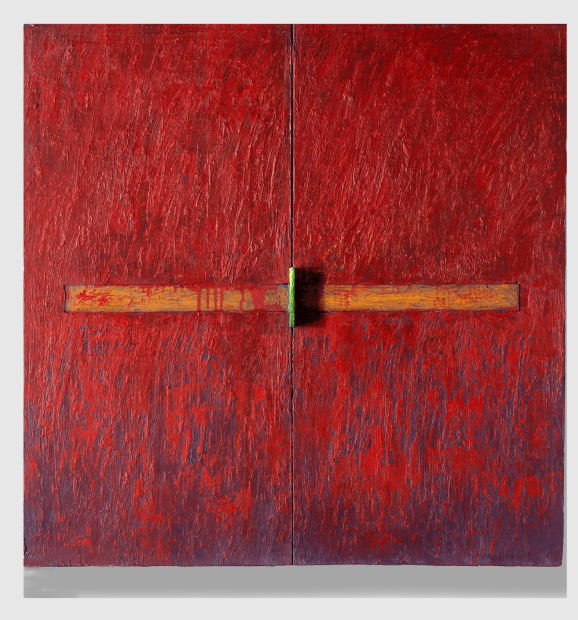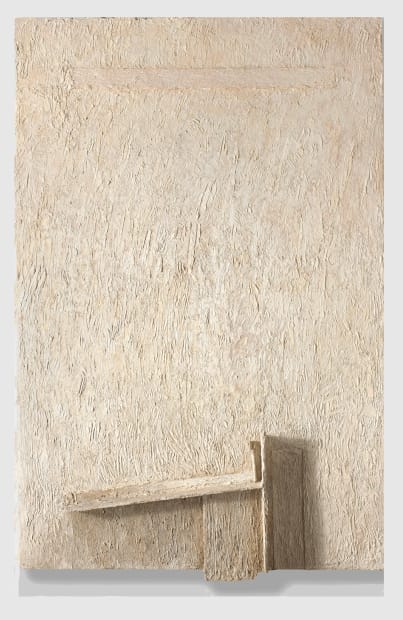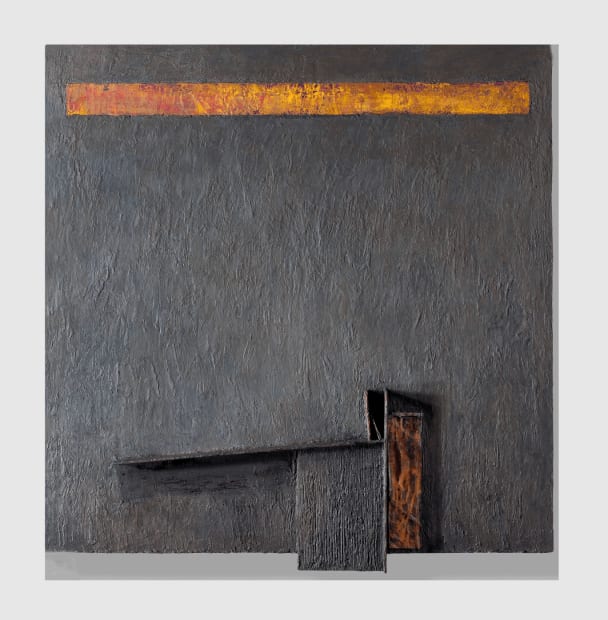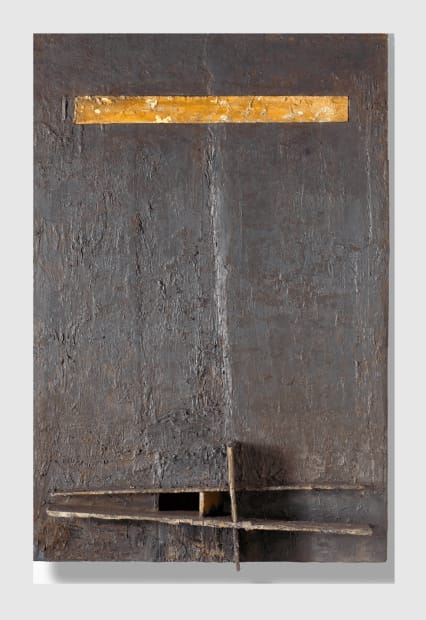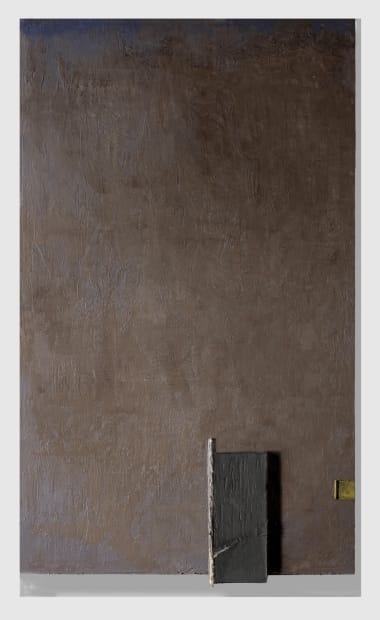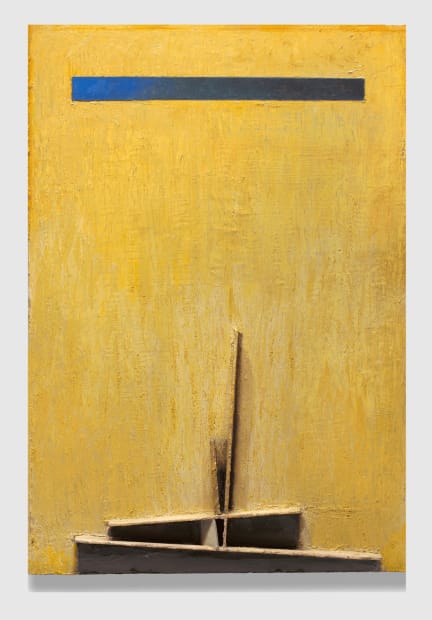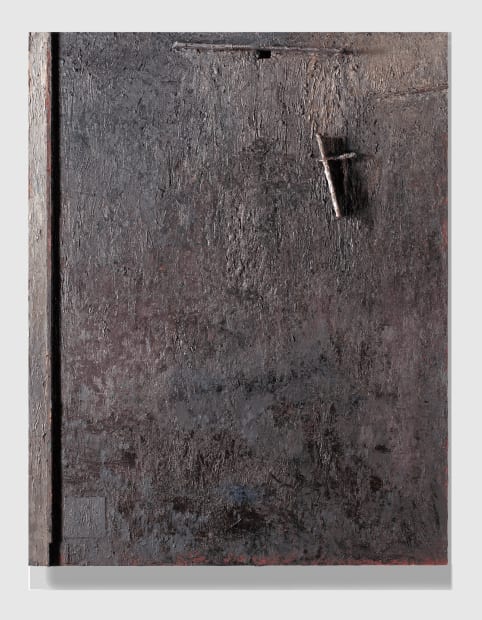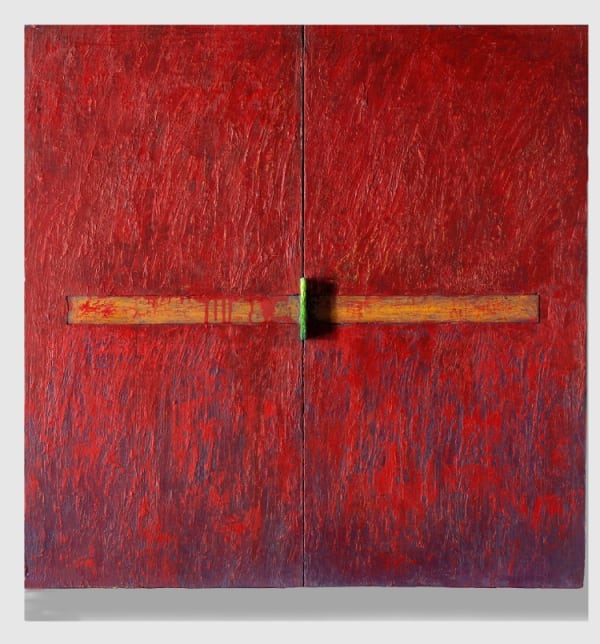(Brian Dickerson) is organically attracted to the shadows, reflections, and other ambiguities that animate the spaces between one dimension and the next, one reality and another, between known and unknown worlds.
On Brian Dickerson’s Constructed Paintings
by Carter Ratcliff
Brian Dickerson calls his works “constructed paintings,” a phrase that warns us, subtly, against relying too heavily on our familiar ways of looking. Face to face with a painting, we usually look into its depths. Even a monochrome canvas preserves the metaphor of window. Dickerson’s paintings persuade vision to stay on their surfaces, which are inexhaustibly rich. After covering a birch panel with gesso, he applies layers of paint, often scraping them down in preparation for further layers. The resulting textures evoke the effects of weather and long seasons of intense sunlight. You feel the weight of his works, for they are objects as much as they are images. Yet Dickerson is not a sculptor.
Rothart, 2010-2023, is a heavily textured field of warm yellow that shades off, here and there, to a light beige. Dickerson’s layering ensures that his colors are difficult to pin down, so much so that the modulation of a hue sometimes looks like a shift in the light. Toward the top of Rothart a thin strip of painted wood runs parallel to the work’s upper edge; parallel to this strip is another, this one painted onto the surface. Along the lower edge, Dickerson has attached a spare but complex configuration of painted strips, some long, some short, and nearly all of them out of alignment with Rothart’s edges.
Fascinating in themselves, these forms could be seen as a hieroglyph for an architectural remnant and, by extension, for the persistence of human artifacts through the long eons of history. Among the artist’s formative experiences were visits to the site of an archeological excavation near the town, in upstate New York, where he was raised. Dickerson has said he “identified with the process of archeology … the role of intuition, burial, the past, what is known and unknown.”
The painted strips in Ash, 2022-2023, form an opening into the surface of the painting. Appearing often in Dickerson’s paintings, these openings never fail to intrigue. You wonder how far they reach into the fictive spaces they imply—how far and along what paths? There are suggestions of labyrinthine interiors, of lost recesses containing who knows what? Having posed that question, we can’t help speculating about the layered, textured surfaces of Dickerson paintings. What have they rendered invisible? Always enlivened, quietly, by earlier stages they never quite hide, these surfaces hint at his abiding awareness of the past—including the history of whatever piece he is working on.
The attached elements in Fallow Field, 2021-2022, are large enough to recall the angular compositions of Piet Mondrian, Kazimir Malevich, and other geometric abstractionists of the twentieth century. These painters are among Dickerson’s ancestor figures, though his earliest works were landscape paintings with a traditional progression from foreground to middle ground to background. Most of them were nocturnes and their darkness may have foretold the mysteries that render his mature works so absorbing.
Dickerson was drawn beyond landscape painting by such earthworks as Michael Heizer’s Double Negative 1969—or, rather by the contrast between the real space this work occupies and the “imagined space” of its photographic reproductions. Never a literalist, Dickerson inflects the strong physical presence of his forms with colors and textures that activate the imagination—as his imagination was activated by the seeming emptiness of Ad Reinhardt’s Black Paintings. Dispensing with the heritage of geometric abstraction, the Black Paintings may well have shown Dickerson the way beyond traditional composition to the previously uncharted territory occupied by his constructed paintings.
There is no precedent for Dickerson’s combination of textured field and sparse architectural elements—a mixture that produces a startling mutability of scale. For we can see these elements as precisely the size they are, as miniatures that draw us in for a close-up examination, or as massive forms seen on high from a great distance. This distance is of course spatial and yet we could understand it as temporal, an interpretive shift prompted the thought that every object or image or memory is a residue—a ruin—that has persisted through time and change to become whatever it is for us in our moment.
This could be a gloomy thought. A happier thought is that each of Dickerson’s constructed paintings is the result of an evolution from the simplicity of a blank surface to an inexhaustibly engaging complexity. Not to mention a subtle kind of beauty. For his art guides us into a present charged with the intensity of now—the sheer presence of his forms, colors, and textures—and yet enriched by endless traces of the past.
An encounter with one of Brian Dickerson's constructed paintings, with their slowly accreted surfaces and mysterious openings, asks us to move with the artist from what is seen to what cannot be seen.
Brian Dickerson was raised in rural Middleburgh, New York in the 1950s and 60s.
He attened the National Academy of Fine Arts and the Pennsylvania Academy of the Fine Arts and earned his BFA from Arcadia University and an MFA from Norwich University - Vermont College. Dickerson has taught at the Art Institute of Philadelphia, Drexel University, Arcadia University, Philadelphia University and Moore College of Art, Philadelphia PA
The recipient of Franz & Virginia Bader Fund Grant and Ballinglen Foundation Fellowship, Brian Dickerson's work has been exhibited in numerous galleries and museums including Kouros Gallery, and OK Harris Gallery, NYC, Benjamin Mangle Gallery and Seraphin Gallery, Philadelphia, PA, Bill Lowe Gallery, Atlanta. American University, Washington, DC , Museum of the University of Wyoming, Butler Institute of American Art, National Academy of Design, Delaware Art Museum and the Pennsylvania Academy of the Fine Arts.
-

BRIAN DICKERSON | Constructed Paintings & Drawings
LIGHTFORMS | 743 Columbia St. Hudson, NY 12534 July 15 - August 20, 2023BRIAN DICKERSON · Constructed paintings & drawings LIGHTFORMS 743 Columbia St. Hudson, NY 12534 Phone: (518) 822 1003 Gallery Hours: Friday: 3-8 PM Sat. & Sun. 2-6 PM By Appt....Read more -

(With)in or (With)out - The Significances of Borders and Boundaries
Binnen of Buiten - de Betekenis van Grenzen en Begrenzingen | 's Hertogenbosch, Noord Brabant, Netherlands | May 24 - June 20, 2023( 's Hertogenbosch, Netherlands) - From May 24 to June 20, the art space of the Milk Factory presents a group exhibition titled (With)in or (With)out - The Significances of...Read more

